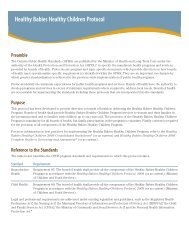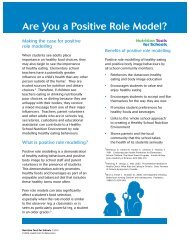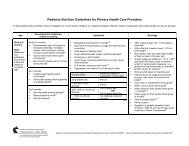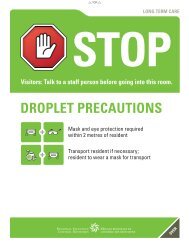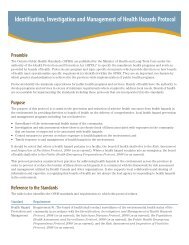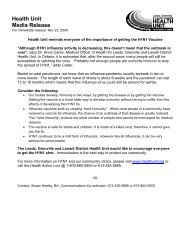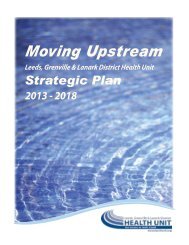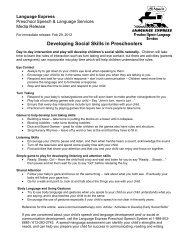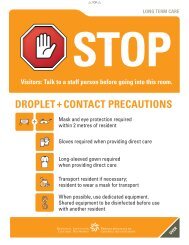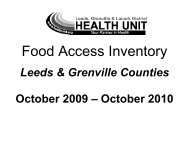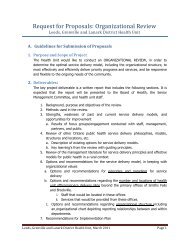Red Flags â - Leeds, Grenville and Lanark District Health Unit
Red Flags â - Leeds, Grenville and Lanark District Health Unit
Red Flags â - Leeds, Grenville and Lanark District Health Unit
Create successful ePaper yourself
Turn your PDF publications into a flip-book with our unique Google optimized e-Paper software.
INTRODUCTION<br />
Early Identification<br />
Thanks to Dr. Fraser Mustard <strong>and</strong> other scientists,<br />
most professionals working with young children<br />
are aware of the considerable evidence about<br />
early brain development <strong>and</strong> how brief some<br />
of the “windows of opportunity” are for optimal<br />
development of neural pathways. The early years<br />
of development from conception to age six,<br />
particularly for the first three years, set the base<br />
for competence <strong>and</strong> coping skills that will affect<br />
learning, behaviour <strong>and</strong> health throughout life 1 .<br />
It follows, then, that children who may need<br />
additional services <strong>and</strong> supports to ensure<br />
healthy development must be identified as<br />
quickly as possible <strong>and</strong> referred to appropriate<br />
programs <strong>and</strong> services. Early intervention during<br />
the period of the greatest development of neural<br />
pathways, when alternative coping pathways<br />
are most easily built, is critical to ensure the best<br />
outcomes for the child. Time is of the essence!<br />
What is <strong>Red</strong> <strong>Flags</strong>?<br />
<strong>Red</strong> <strong>Flags</strong> is a quick reference guide for Early<br />
Years professionals. It can be used in conjunction<br />
with a validated screening tool, such as Nipissing<br />
<strong>District</strong> Developmental Screens (the Nipissing<br />
Screen 2 ) or Ages <strong>and</strong> Stages Questionnaire<br />
(ASQ). <strong>Red</strong> <strong>Flags</strong> outlines a range of functional<br />
indicators or domains commonly used to<br />
monitor healthy child development, as well as<br />
potential problem areas for child development.<br />
It is intended to assist in the determination of<br />
when <strong>and</strong> where to refer for additional advice,<br />
formal assessment <strong>and</strong>/or treatment.<br />
Who should use <strong>Red</strong> <strong>Flags</strong>?<br />
This quick reference guide is intended to be<br />
used by any professional working with young<br />
children <strong>and</strong> their families. A basic knowledge<br />
of healthy child development is assumed. <strong>Red</strong><br />
<strong>Flags</strong> will assist professionals in identifying when<br />
a child could be at risk of not meeting his health<br />
<strong>and</strong>/or developmental milestones, triggering an<br />
alert for the need for further investigation by the<br />
appropriate discipline.<br />
How to use this document<br />
This is a quick reference to look at child<br />
development by domain, reviewing each domain<br />
from birth to six years (unlike screening tools<br />
that look at a particular child’s development<br />
across many areas of development at a specific<br />
age). It includes other areas that may impact<br />
child health, growth <strong>and</strong> development due to<br />
the dynamics of parent-child interaction, such as<br />
postpartum depression, abuse, etc.<br />
<strong>Red</strong> <strong>Flags</strong> allows professionals to review <strong>and</strong><br />
better underst<strong>and</strong> domains on a continuum<br />
that are traditionally outside their own area of<br />
expertise. This increased awareness will help<br />
professionals better underst<strong>and</strong> when <strong>and</strong> where<br />
to refer for further investigation or treatment.<br />
Use <strong>Red</strong> <strong>Flags</strong> in conjunction with a screening<br />
tool, such as Nipissing <strong>District</strong> Developmental<br />
Screens or Ages Stages Questionnaire (ASQ) to<br />
review developmental milestones <strong>and</strong> problem<br />
signs in a particular domain or indicator. Some<br />
information is cross-referenced to other domains,<br />
such as speech with hearing, to assist the<br />
screener in pursuing questions or ‘gut feelings’.<br />
If children are not exhibiting the milestones<br />
for their age, further investigation is needed. If<br />
using Nipissing <strong>District</strong> Developmental Screens,<br />
remember that the screening tools are ageadjusted;<br />
therefore, the skills in each screen are<br />
Footnotes<br />
1. Early Years Study: reversing the real brain drain, Hon.<br />
Margaret McCain <strong>and</strong> Fraser Mustard, April, 1999. See report<br />
at www.eldis.org/ .<br />
2. Nipissing <strong>District</strong> Developmental Screens refer to 13<br />
parent checklists available to assist parents to record <strong>and</strong><br />
monitor development of children from birth to age 6. The<br />
screens cover development related to vision, hearing,<br />
communication, gross <strong>and</strong> fine motor, social/emotional<br />
<strong>and</strong> self-help <strong>and</strong> offers suggestions to parents for age<br />
appropriate activities to enhance child development.<br />
Parents are encouraged to call the <strong>Health</strong> Action Line of the<br />
<strong>Leeds</strong>, <strong>Grenville</strong> <strong>and</strong> <strong>Lanark</strong> <strong>District</strong> <strong>Health</strong> <strong>Unit</strong> at 1-800-660-<br />
5853 if two or more items are checked ‘No’. A public health<br />
nurse will review the results of the screen <strong>and</strong> suggest next<br />
steps. It is particularly important for a screen to be reviewed<br />
by a professional if a problem is identified. For additional<br />
information about Nipissing <strong>District</strong> Developmental Screens<br />
or to obtain copies, visit the website at www.ndds.ca<br />
2 <strong>Red</strong> <strong>Flags</strong>: Early Identification in <strong>Leeds</strong>, <strong>Grenville</strong> & <strong>Lanark</strong> November 2007



